As parents, we know that diaper changes are a constant, especially when you’re on the go. While convenience is key, many portable changing pads on the market can be flimsy, hard to clean, or just not quite the right size. That’s where the joy of DIY comes in! Creating your own Travel Changing Pad allows you to customize it to your exact needs and preferences, ensuring both comfort for your baby and practicality for you.
This easy sewing tutorial is perfect for beginners and seasoned sewers alike. Inspired by my own journey into motherhood and sewing, this project is designed to be simple, customizable, and incredibly useful. Like many parents, I found store-bought changing pads lacking – often too small for growing babies and difficult to clean. This DIY travel changing pad addresses those issues, offering a larger, washable, and personalized solution. Let’s dive into creating a travel changing pad that’s not only functional but also a testament to your crafting skills!
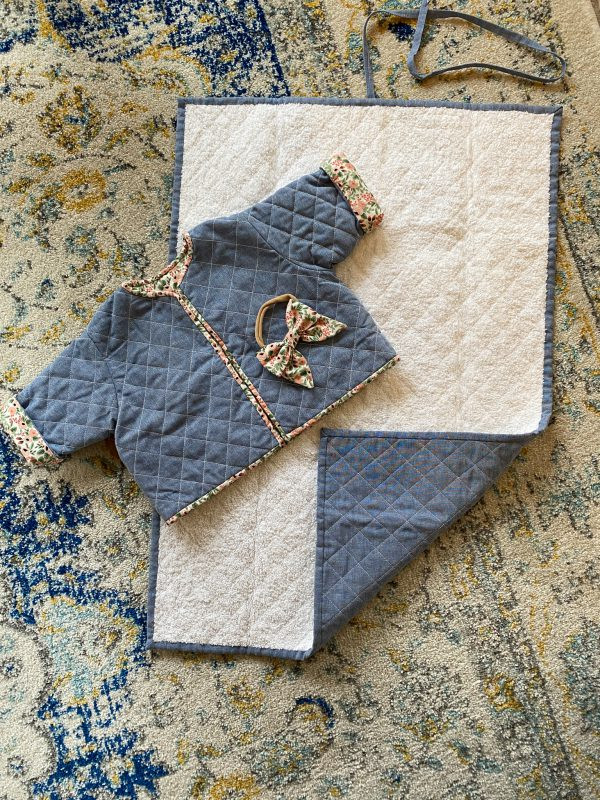
A finished DIY travel changing pad, folded neatly and tied with a fabric strip, showcasing its portability and handmade charm.
Materials You’ll Need to Sew Your Own Travel Changing Pad
Before we begin, gather these readily available materials. You can easily personalize your travel changing pad by choosing fabrics and patterns that match your style or baby’s nursery theme.
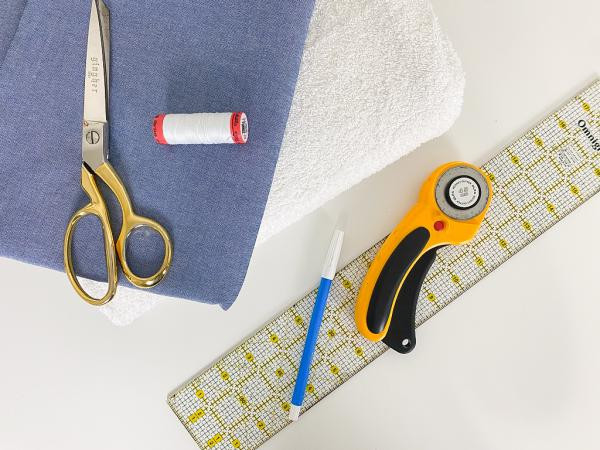 DIY_TRAVEL_CHANGING_PAD
DIY_TRAVEL_CHANGING_PAD
Essential materials for creating a travel changing pad, including a towel, fabric backing, and sewing tools laid out on a crafting surface.
- Towel: One standard-size towel. A soft and absorbent towel is ideal. Consider using a towel from Target’s Room Essentials line as used in this tutorial, or repurpose an old towel.
- Fabric Backing: 1 yard of fabric. Choose a cotton fabric or a fabric that complements your towel. This will be the outer layer of your travel changing pad.
- Quilting Ruler: For accurate measurements and straight lines.
- Rotary Cutter: Makes cutting fabric quicker and more precise, but scissors will also work.
- Cutting Mat: Protects your work surface while cutting.
- Scissors: For trimming threads and fabric.
- Pins: To hold fabric layers together before sewing.
- Water-Soluble Pen: For marking fabric; ensures markings disappear after washing.
- Coordinating Thread: Choose a thread color that matches your fabric for a professional finish.
- Sewing Machine: A BERNINA 590 E sewing machine is used in the original tutorial, but any sewing machine will work for this project.
Step-by-Step Guide to Sewing a Travel Changing Pad
Follow these simple steps to create your own practical and stylish travel changing pad. Remember, this is a customizable project, so feel free to adjust dimensions or add personal touches!
Step 1: Cut the Fabric and Towel
Lay your chosen fabric and towel flat on your cutting mat. Using your quilting ruler and rotary cutter (or scissors), cut a rectangle of 28 inches by 20 inches from both the fabric and the towel. These dimensions provide a generous size for most babies while remaining portable.
 DIY_TRAVEL_CHANGING_PAD
DIY_TRAVEL_CHANGING_PAD
Fabric and towel pieces cut into 28×20 inch rectangles, ready for the next step in creating the travel changing pad.
Step 2: Mark Diagonal Lines on the Fabric Backing
Take the right side of your fabric backing piece. Using your water-soluble pen and quilting ruler, mark diagonal lines that are 1 inch apart, starting from the bottom left corner and moving across the fabric. These lines will create a grid pattern for quilting.
Close-up showing diagonal lines being marked with a water-soluble pen on the fabric backing of the travel changing pad.
Step 3: Pin and Topstitch the First Set of Diagonal Lines
Place the marked fabric backing piece on top of the wrong side of the towel piece. Pin the two layers together securely to prevent shifting during sewing. Begin topstitching along the marked diagonal lines, starting from the center and working outwards towards one corner. Repeat this process for the other side, ensuring the fabric and towel layers remain aligned.
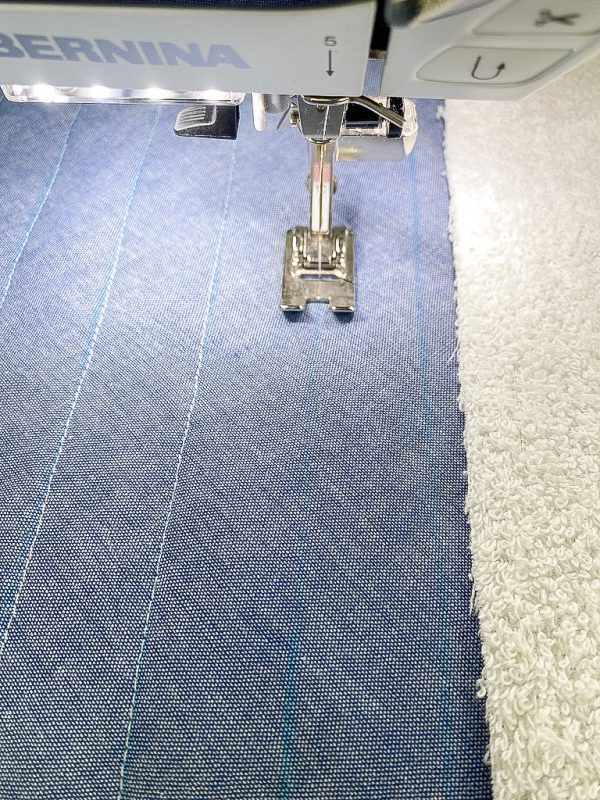 DIY_TRAVEL_CHANGING_PAD_DIY_BABY_PROJECT
DIY_TRAVEL_CHANGING_PAD_DIY_BABY_PROJECT
Sewing the first set of diagonal lines on the travel changing pad, securing the fabric backing to the towel.
Step 4: Mark the Second Set of Diagonal Lines
Now, mark the second set of diagonal lines, again 1 inch apart, starting from the bottom right corner. These lines will intersect with the first set, creating a 1-inch square grid pattern across the travel changing pad.
Step 5: Topstitch the Second Set of Lines
Topstitch along these newly marked diagonal lines, following the same technique as in Step 3. Sew from the center outwards to each corner. This completes the quilted pattern on your travel changing pad, adding both visual appeal and structure.
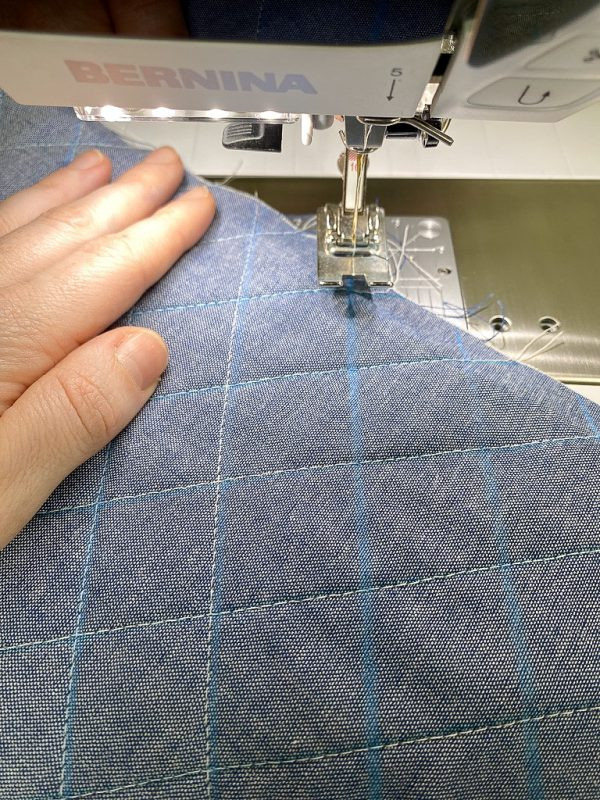 DIY_TRAVEL_CHANGING_PAD_DIY_BABY_PROJECT
DIY_TRAVEL_CHANGING_PAD_DIY_BABY_PROJECT
The second set of diagonal lines being sewn, completing the quilted square pattern on the DIY travel changing pad.
Step 6: Trim and Even Out the Sides
Return your travel changing pad to the cutting mat. Use your rotary cutter and quilting ruler to trim any uneven edges, ensuring all sides are straight and the rectangle is perfectly sized. This step is crucial for a neat and professional finish.
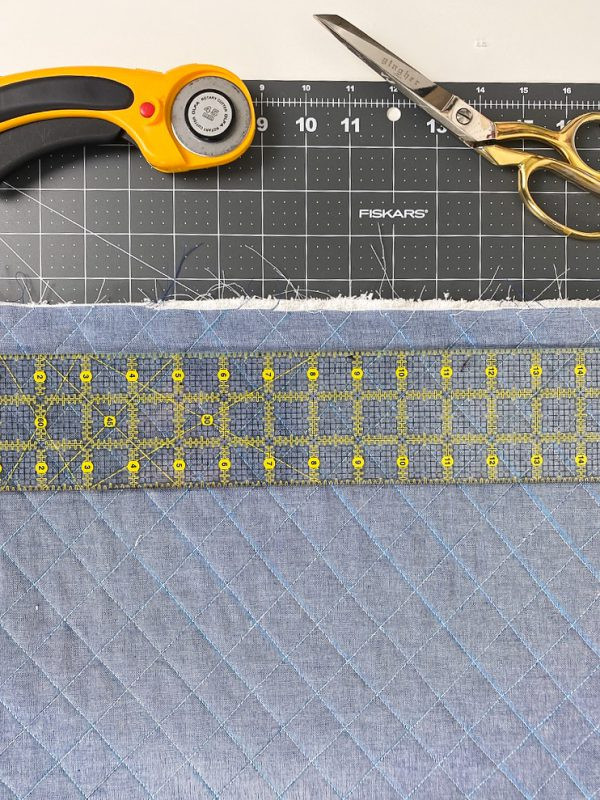
Trimming the edges of the travel changing pad with a rotary cutter and ruler to create clean, even sides.
Step 7: Prepare the Binding Strips
Measure the perimeter of your travel changing pad. Cut fabric strips that are 1.5 inches wide and long enough to go around the entire edge of the changing pad, plus a few extra inches for overlap. Iron these strips in half lengthwise, with the wrong sides facing each other, creating a neat binding.
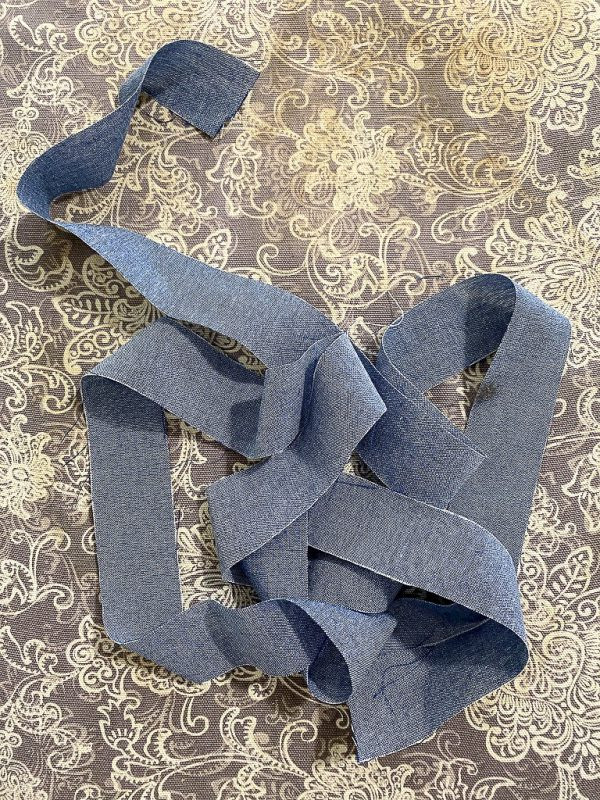 DIY BABY PROJECT
DIY BABY PROJECT
Ironing fabric strips in half to create binding for the edges of the DIY baby project, the travel changing pad.
Step 8: Create the Fabric Tie
Cut a strip of fabric measuring 1 inch by 27 inches. Fold it in half lengthwise, right sides together, and iron. Sew along the long edge with a 1/2-inch seam allowance, leaving the top end open for turning. Turn the tie right side out using a loop turner or safety pin, and iron it flat.
Step 9: Position the Fabric Tie
Place the fabric tie in the center of the top edge of the travel changing pad. Ensure the long side of the tie is facing inwards towards the changing pad to prevent it from getting caught in the binding during the next step. Pin it in place securely.
Step 10: Bind the Travel Changing Pad
Attach the binding to the edge of the travel changing pad, encasing the raw edges and the fabric tie. Start sewing the binding from the back, then flip it to the front and topstitch it in place for a clean and finished edge. Refer to online binding tutorials if you are new to this technique.
 Binding – Travel Changing Pad
Binding – Travel Changing Pad
Step 11: Remove Water-Soluble Pen Marks
Once the binding is complete, remove any visible water-soluble pen marks. You can gently dab them with a damp cloth or, as suggested in the original tutorial, toss the travel changing pad in the washing machine on a delicate cycle for a thorough clean.
Step 12: Iron and Fold Your Travel Changing Pad
After washing and drying, iron your travel changing pad to remove any wrinkles and give it a crisp look. To fold it into a compact satchel shape, fold it vertically into thirds. Then, fold the top section slightly more than halfway down. Wrap the fabric tie around the folded pad and knot it in the front to secure it closed.
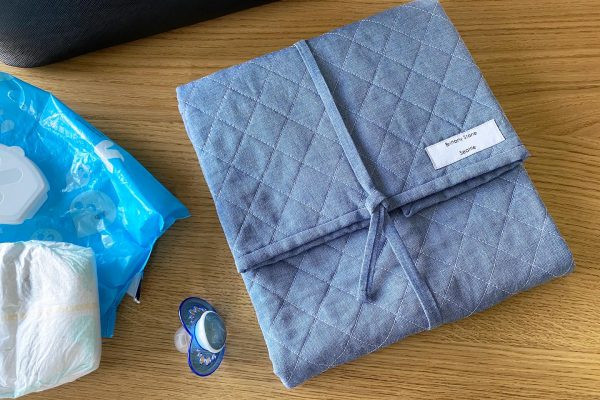
Step-by-step folding process of the travel changing pad, showing how to achieve a compact and satchel-like closure.
The final folded DIY travel changing pad, demonstrating its compact size and readiness for use on the go.
Congratulations! You have now sewn your very own DIY travel changing pad! This project is not only a practical solution for diaper changes on the go but also a thoughtful and handmade gift for baby showers or new parents. We hope you enjoyed this tutorial and feel inspired to personalize your travel changing pad even further. Don’t forget to share your creations with us – we’d love to see your unique versions of this handy baby essential! Happy sewing!
